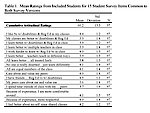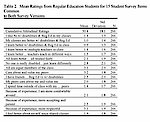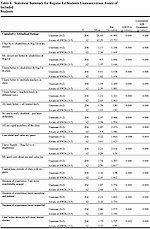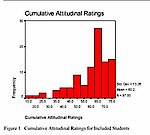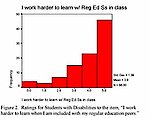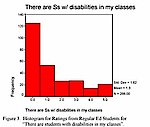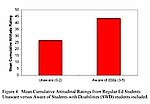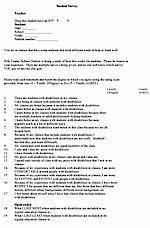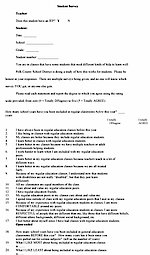Does Inclusion Help Students: Perspectives from Regular Education and Students with Disabilities
Bonnie Dupuis, MA
Facilitator for Inclusive Practices
Polk County Public Schools
Joyce W. Barclay, Ed.S.
Florida Inclusion Network Facilitator
Polk County Public Schools
Sherwin D. Holmes, MS
Director, Exceptional Student Education
Polk County Public Schools
Morgan Platt
Assessment, Accountability & Evaluation
Polk County Public Schools
Steven H. Shaha, PhD, DBA
Director of Research & Evaluation
Performance & Growth through Impacts (PGI)
Corresponding Author:
Valerie K. Lewis, MPA
President and CEO
Performance & Growth through Impacts (PGI)
2174 New Horizon Drive
Sandy, UT 84093
(801) 943-0358
Fax (801) 947-0842
lewisva@comcast.net
This research focused on verifying the impacts of Inclusion on both students with disabilities (SWDs) and their Regular Ed classmates. High school students (n=364) within inclusive classes completed surveys reflecting their perceptions of the effectiveness of the learning environment and the attitudinal impacts of Inclusion. Results documented significant positive attitudinal and self-reported learning impacts of Inclusion for both SWDs and Regular Ed peers. SWDs reported higher self-concept, liking of school and teachers, and greater motivation to work and learn. Unexpectedly, Regular Ed student responses followed the same patterns, reflecting significantly higher attitudes across the board and perceived academic achievement, as well as higher tolerance for SWDs. The importance of anonymity for SWDs is discussed in light of significantly higher attitudinal ratings among Regular Ed students most aware of the presence of SWDs. Implications for the future of Inclusion are discussed.
Introduction
The value and impact of education has been clearly defined as a balance not only of achievement and learning, but also of the attitudinal, social and personality-based effects on students (Bernhardt, 1998; Daniels, 2002; Dewey, 1916; Lewis & Shaha, 2003). The importance of the two-fold measurement of success is nowhere more important than for the subset of students whose learning and physical needs make school either challenging or overwhelming. In the age of accountability, the goals of Inclusion must echo those of education as a whole: to help Students with Disabilities gain the maximum in attitudinal impacts and social benefits from their school experiences (Baker & Zigmond, 1995; Fuchs & Fuchs, 1988; Salisbury, Gallucci, Palombaro & Peck, 1995; Soodak, Podell & Lehman, 1998).
Much research has focused on establishing the validity of the argument that Inclusion is beneficial to Students with Disabilities. Studies have shown that Students with Disabilities benefit socially with fewer negative labels, reduced stigma, and increased interaction with Regular Ed peers (Brady & Taylor, 1989; Huefner, 1988; Snyder, 1999; Wang & Birch, 1984). Some evidence suggests that achievement and learning for Students with Disabilities may also be benefited by Inclusion (Barclay, Holmes, Elmore, Dupuis, Lewis, & Shaha, 2006; Soodak, Podell & Lehman, 1998).
For many educators, however, the practice of Inclusion remains clouded in controversy (Davis, 1989; Fuchs, Fuchs & Fernstrom, 1993; Klingner, Vaughn, Schumm, Cohen & Forgan, 1998). While much can be found regarding the apparently favorable impact of Inclusion on Students with Disabilities, little research addresses the potentially negative impact on the Regular Ed Students. It may be considered “politically incorrect” to question such an important and sensitive topic that emphasizes the needs of the disabled, hence the paucity of data asking the risky questions.
Do we think so little of Inclusion that we don’t dare ask the full set of questions regarding its impact on the entire range of students? Do we favor the few so sensitively that we are unwilling to be concerned about the Regular Ed Students whose classrooms are being adapted to meet the needs of others? Are we truly committed to the educational experience of all students, and if so are we as educators willing to ask the frightening questions regarding the impact of Inclusion on all students? If as much as $60 billion a year is spent on the 12 percent of Students with Disabilities, do we not have an obligation to document whether that lop-sided expenditure represents any benefit to Regular Ed Students (Kavale, 2002)? On the other hand, do Students with Disabilities experience favorable attitudes toward learning and their personal capabilities within inclusive settings, or are the benefits only social?
The purpose of this research was to quantify the attitudinal impacts of Inclusion on both Students with Disabilities and their Regular Ed classmates. Our objective was to verify claims by other researchers that Students with Disabilities prefer and feel benefited by Inclusive classroom settings. In addition, our design was to answer the more dangerous, more sensitive and too-seldom-asked questions regarding the impact of Inclusion on the Regular Ed Students into whose classroom the Students with Disabilities have been included.
Method
The Student Survey was created collaboratively in two versions for assessing the attitudinal impacts of Inclusion on students and their perceptions of Inclusion. Representatives engaged in the creative process included three key high school leaders, three district Inclusion resource personnel, a local university expert in exceptional student education, and two professional survey design experts as consultants (Shaha, Lewis, O’Donnell & Brown, 2004). The language, structure and execution methodology for the Survey were designed to ensure privacy and anonymity for the students, and adherence to politically correct language.
The Student Survey was developed in two versions, one for each student type (see Appendices A and B). Both versions included 17 “identical” items: 15 were Likert-scaled items (ratings from 0 to 5), and two were open-ended items. The items used virtually identical wording for each of the two survey versions, the only difference being the substitution of student type labels for each of the complimentary versions. In addition to the identical items, the Student Survey version for Students with Disabilities included three non-identical items (20 items total) regarding their personal experience within Regular Ed classrooms. The version for Regular Ed students included two additional non-identical items (19 items total) regarding their perceptions of Students with Disabilities sharing classroom experiences. All items required response except for the two open-ended items.
All students voluntarily completed the web-based Student Survey in the computer lab during the same one-week time period in the spring term of 2005. The resulting response rate was 100%, and no student chose not to complete the survey. To protect crucial student privacy and anonymity during participation in the Student Survey, a teacher initiated the survey process for each student by first answering the question, “Does this student have an IEP?” If the answer was “yes” (i.e. this is a Student with Disabilities), the respondent was presented the survey for Students with Disabilities (see Appendix A). Conversely, if the answer was “no” to the IEP question, the respondent was presented the survey for Regular Ed students (see Appendix B). Directions for students clarified that there were multiple versions of the survey so as to not draw attention to visible differences in Survey items for Students with Disabilities versus Regular Ed classmates.
Respondents to the Student Survey included 364 high school students (grades 9-12) enrolled in intact, inclusive classrooms within a single high school in rural Florida, including 98 Students with Disabilities and 266 Regular Ed students. The study was limited to a single High School setting in order to increase interpretive and inferential capabilities by reducing as much as possible any explanations of findings attributable to differences between school settings, leadership, or other variables. Inclusive classrooms were defined as those in which Students with Disabilities were intentionally placed among Regular Ed Students as part of the District and High School Inclusion program (c.f. Fink, 2004). The classes engaged in the study were limited to mathematics, English and reading. Inclusive classrooms reflected a structure involving two teachers each for the entire classroom period, including one Regular Ed teacher, and one additional SWD expert resource in a co-teaching model. Students with Disabilities included those students classified as SWDs based on Florida State Department of Education guidelines (State Guidelines, 2006). All other respondents were classified as Regular Ed students.
All analyses were conducted using SPSS (ver 11.0 or higher). Responses for Likert-scaled items (0-5) were categorized as favorable when group means were equal to or greater than 2.5, wherein 0-2 represented unfavorable responses and 3-5 represented favorable. Cumulative Attitudinal Rating scores were created by summing the 15 Likert-scale items uniform between survey versions (i.e. versions for Included and Regular Education students) – the maximum Cumulative Rating was, therefore, 75.
Results
Attitudinal Impacts on Students
Responses to the web-administered Student Survey were analyzed, including responses from 364 students participating in inclusive classrooms. Students with Disabilities represented 26.9 percent (n=98) of the respondents, and Regular Ed student represented 73.1 percent (n=266).
Included Students
Data clearly established that students with disabilities included in regular education classrooms were uniformly and systematically positive (ratings of 3 or greater) in their motivation and fulfillment, and reported being focused and successful, academically and socially (see Table 1). Per-item data indicated highly favorable attitudinal impacts of inclusion on Included Students with Disabilities for every item. Cumulative Attitudinal Ratings (see Figure 1) were very favorably skewed with a mean of 60.2 of the maximum 75.
One item on the Student Survey was unique for Included Students with Disabilities: “I work harder to learn when I am included with my regular education peers.” Data showed that Included Students with Disabilities reported highly favorable tendencies to “work harder to learn” in the inclusive classroom settings (see Figure 2).
Regular Education Students in Inclusive Classrooms
Analyses of data from the Regular Education Students revealed mix favorable and unfavorable results (see Table 2). The mean Cumulative Attitudinal Rating was 30.38 of the maximum 75, a value that was near but below the mid-point of 35. Per-item analyses showed favorable mean ratings (means > 2.5) for six of the 15 items, while unfavorable results were found for the other nine items.
Superficial interpretation of the unfavorable response patterns was found to be misleading as a result of further analyses conducted. Investigation into the data revealed a fascinating phenomenon that uncovered a highly favorable underlying pattern among the Regular Ed Students that is best explained through a two-step analytic process:
Step 1. “Anonymity.” The first step involved examination of responses by Regular Ed Students to the item unique to their version of the survey that read, “There are students with disabilities in my classes.” Data indicated that 47.0 percent of the Regular Ed Student respondents – remembering that they are all in inclusive classrooms – reported being completely unaware of the presence of the Included peers with disabilities (see Table 3 and Figure 3). A total of 76.7 percent of the Regular Ed Students reported little or no awareness (ratings of 2 or lower) of the presence of Students the Disabilities in their Inclusive classes. Fully 47.0 percent of the Regular Ed Students reported no awareness of the Included peers. Based on this pattern, correlational analyses were undertaken to discern whether attitudinal responses differed for Regular Ed Students aware versus unaware of their peers with disabilities.
Step 2. Correlation of Attitudes with Level of Awareness. Data were therefore further scrutinized to understand response patterns correlated with levels of awareness. Regular Ed Students were grouped into two subgroups as either Aware (ratings from 3-5) or Unaware (ratings from 0-2) that students with disabilities were included in their classrooms based on the corresponding survey item. It remains important to remember that 100 percent of responding Regular Ed Students were in Inclusive classrooms.
Results revealed statistically significant correlations between attitudinal ratings and levels of awareness of the presence of Included Students with Disabilities. However, the pattern was somewhat counterintuitive: The greater the awareness of Included students, the higher the attitudinal ratings were for the Regular Ed Students.
ANOVAs were conducted to quantify contrasts between Unaware and Aware groups (see Table 4). Statistically significant differences were verified for Cumulative Attitudinal Ratings (see Figure 3) and for every item, with corresponding p-values of .002 or less (except one item marginally significant at p=.058). All differences favored the significantly higher attitudinal ratings among the students Aware of Students with Disabilities (SWD) (ratings of 3-5 on each respective item). The resulting levels of significance (p-values) are also included in Table 4.
Correlation coefficients were also computed for each item between level of awareness (0-5) and the ratings on each item, leveraging Spearman’s Rho as the statistic of choice (Kendall’s Tau for confirmatory purposes). Statistically significant correlations were verified for every item, and every item had a corresponding p-value of less than .001 (see right-most column of Table 4). The interpretation of the correlation is that “the higher the level of awareness among Regular Ed Students of the presence of Included Students with Disabilities, then the higher their attitudinal ratings” for each item.
Conclusion and Discussion
Results clearly document the positive attitudinal impacts of Inclusion for both Students with Disabilities and their Regular Education peers. Students with Disabilities uniformly reported being highly motivated and fulfilled, and reported being focused and successful both academically and socially. Students with Disabilities reported better social and learning environments in inclusive settings furthering their motivation to learn and to work harder. Included Students with Disabilities reported that their learning proficiency increased with the Regular Ed Students along side them.
While the favorable attitudes among Students with Disabilities could have been expected, the favorable results for Attitudes of Regular Ed Students were encouraging. What was most validating was the discovery that highest attitudes were correlated with higher awareness of the inclusion of peers with disabilities. This is a fascinating finding that suggests that Regular Ed Students are happier and more positive about the classroom, their peers, their personal learning and themselves when they are aware of the inclusiveness of the setting (c.f. Huefner, 1988; Wang & Birch, 1984). This finding suggests that the more they know and understand about their environment the less they may be encumbered by any potential inconveniences that inclusive classroom settings might bring.
Another finding in this study is that Regular Ed students were on the whole unaware of the included students and unable to identify students with disabilities in their inclusive classes. For many included students, this apparent blindness to their disabilities is precisely the anonymity they desire and prefer, as they want their disabilities to be invisible so they can be “just like their peers without disabilities.” In high school they just want to learn and participate in school classes and activities and not be singled out because of their disabilities.
The desire for anonymity among the Students with Disabilities seems to be in conflict with the apparently favorable effects of informed Regular Ed Students. It would potentially be dangerous to the beneficial impacts of Inclusion to purport that Regular Ed Students should be fully informed of the disabilities of their invisible classmates that appear normal (c.f. Davis, 1989; Snyder, 1999). The main question remaining is how do we balance the need for anonymity for students with disabilities with the need for awareness for their peers without disabilities. More research is needed to discern a clearer understanding of the needs of all students in inclusive classroom settings. In the absence of such research, however, these data clearly show that Inclusion is mutually beneficial to the attitudes of both Students with Disabilities and their Regular Ed peers, and that Inclusive practices should not be held back pending more data.
The data in this research were limited to the attitudes of high school students in order to maximize the precision and interpretability of the findings. While further research is needed involving other age groups, in our opinions there is no reason to believe that the positive attitudes expressed toward Inclusion by either student type would be different in any negative sense. We particularly anticipate that to be the case for the interesting balance uncovered between the desire for anonymity on the part of the Students with Disabilities, and the benefits of awareness on the part of the Regular Ed classmates.
The goals of education remain increased learning and best social impacts. Inclusion has been proven once again to be a valid and favorable approach for meeting those goals for both Students with Disabilities, and also their Regular Ed peers. Taken in concert with recently established correlation between the attitudinal impacts and achievement gains for both Included and Regular Ed students (c.f. Barclay, Holmes, Elmore, Dupuis, Lewis & Shaha, 2006; Elmore, Collins, Lewis & Shaha, 2006), and the overwhelmingly positive attitudinal impacts on both Special and Regular Ed teachers (Barclay, et.al, 2006), little question or controversy remains as to the favorable attitudinal power inclusion provides for students.
References
Baker, J.M. & Zigmond, N. (1995). The meaning and practice of inclusion for students with learning disabilities: Themes and implications from the five cases. The Journal of Special Education, 29, 163-180.
Barclay, J., Holmes, S., Elmore, D., Dupuis, B., Lewis, V. & Shaha, S.H. (2006). Closing the Gap: Inclusion for maximizing the impact of exceptional student education programs. International Conference on Education: Proceedings. Honolulu. 4, 229.
Bernhardt, V. (1997). Data analysis for comprehensive school-wide improvement. Larchmont, NY: Eye on Education.
Brady, M.P. & Taylor, R.D. (1989). Instructional consequences in mainstreamed middle-school classes: Reinforcement and corrections. Rural and Special Education, 10, 31-36.
Daniels, S.E. (2002). First to the top. Quality Progress, May, 2002.
Davis, W.E. (1989). The Regular Education Initiative debate: Its promises and problems. Exceptional Children, 55, 440-446.
Dewey, J. (1916). Democracy in Education. Republished in 1966, NY: The Free Press.
Elmore, D., Collins, D., Lewis, V. & Shaha, S.H. (2006). Smaller Learning Communities: A high school in crisis soars. International Conference on Education: Proceedings. Honolulu. 4, 1801.
Fink, J. (2004). Conclusions on inclusion. The Clearing House. 77(6), 272-274.
Fuchs, D. & Fuchs, L.S. (1988). An evaluation of the Adaptive Learning Environments Model. Exceptoinal Children. 55, 115-127.
Fuchs, D., Fuchs, L.S. & Fernstrom, P. (1993). A conservative approach to special education reform: Mainstreaming through transenvironmental programming and curriculum-based measurement. American Educational Research Journal. 30, 149-177.
Huefner, D.S. (1988). The consulting teacher model: Risks and opportunities. Exceptional Children, 54, 403-114.
Kavale, K.A. (2002). Mainstreaming to full inclusion: From orthogenesis to pathogenesis of an idea. International Journal of Disability, Development and Education, 49(2), 201-214.
Klingner, J.K., Vaughn, S., Schumm, J.S., Cohen, P. & Forgan, J.W. (1998). Inclusion or pull-out: Which do students prefer? Journal of Learning Disabilities, 31(2), 148-158.
Lewis, V.K., & Shaha, S. H. (2003). Maximizing learning and attitudinal gains through integrated curricula. Education, 123:3.
Salisbury, C.L., Gallucci, C., Palombaro, M.M. & Peck, C.A. (1995). Strategies the promote social relations among elementary students with and without severe disabilities in inclusive schools. Exceptional Children, 65, 125-138.
Shaha, S.H., Lewis, V.K., O’Donnell, T.J. & Brown, D.H. (2004). Evaluating professional development: An approach in verifying program impact on teachers and students. Journal of Research in Professional Learning. 1(1), pg. 1. Lead article for publication launch.
Snyder, R.F. (1999). Inclusion: A qualitative study of inservice general education teachers’ attitudes and concerns. Education, 120(1), 173.
Soodak, L.C., Podell, D.M. & Lehman, L.R. (1998). Teacher, student, and social attributes as predictors of teachers’ responses to inclusion. The Journal of Special Education, 31(4), 480-497.
State Guidelines for ESE Classification (2006). http://www.firn.edu/doe/eias/dataweb/database_0506/student_0506/st77_25.pdf.
Wang, M.C. & Birch, J.W. (1984). Comparison of a full-time and mainstreaming program and a resource room approach. Exceptional Children, 51, 33-40.
About the Authors:
Bonnie DuPuis. Bonnie DuPuis has over 14 years of experience in educating students from kindergarten to 8th grade. Her greatest passion has been teaching students in inclusive settings. She holds a Masters degree in Varying Disabilities and an Undergraduate degree in Early Childhood Elementary Education. Bonnie has piloted various educational initiatives to assist school districts in providing best practices for all students, including students with significant disabilities.
Sherwin Holmes. Sherwin Holmes holds a Masters of Science in Audiology, a Florida Teaching Certificate for Hearing Impaired K-12 and Certification in Educational Leadership. He has 19 years of experience in education with over 15 years in the administration of Special Education. Sherwin’s current position is the Director of Exceptional Student Education managing an $18,000,000.00 budget in a school district of approximately 90,000 total students.
Joyce Barclay. Joyce Barclay works with the Florida Inclusion Network in Polk County Schools in central Florida. She has an Educational Specialists Degree in Educational Leadership. She has worked in the field of special education for 28 years in the roles of staffing specialist, program coordinator, senior manager, and inclusion facilitator. She also teaches courses in Exceptional Student Education at Florida Southern College in Lakeland, FL.
Valerie K. Lewis. Valerie Lewis has over 15 years of experience in Education from high school teacher to college administrator. Her Masters is in Public Administration. Valerie has worked with multi-million dollar grants on measurement, assessment and continuous improvement to aid Educational organizations. She is currently President and CEO of Performance and Growth through Impacts.
Morgan Platt. Morgan Platt holds graduate and undergraduate degrees in Education and Business Administration. He is an advanced Ph.D. student in Research and Measurement. He has 11+ years experience teaching course in education, as well as research methods and statistics. He has led numerous evaluation projects at the local school district level and oversees a local data management and evaluation company.
Steven H. Shaha. Dr. Steven Shaha holds 2 masters degrees in Education and doctorates in Research Methods and Applied Statistics and in Business Administration. He has presented 150+ papers, has 200+ publications, many chapters and two books, assisted in creating the Baldrige Awards for Education and Healthcare, and has consulted throughout the U.S. and in 13 countries internationally.
Copyright Information
NASET would like to thank The American Academy of Special Education Professionals for the reprint rights of JAASEP Articles.
Copyright and Reprint Rights of JAASEP
JAASEP retains copyright of all original materials, however, the author(s) retains the right to use, after publication in the journal, all or part of the contribution in a modified form as part of any subsequent publication.
JAASEP is published by the American Academy of Special Education Professionals. JAASEP retains copyright of all original materials, however, the author(s) retains the right to use, after publication in the journal, all or part of the contribution in a modified form as part of any subsequent publication.
If the author(s) use the materials in a subsequent publication, whether in whole or part, JAASEP must be acknowledged as the original publisher of the article. All other requests for use or re-publication in whole or part, should be addressed to the Editor of JAASEP.
Request for reprints are to be directed to: editor@aasep.org
